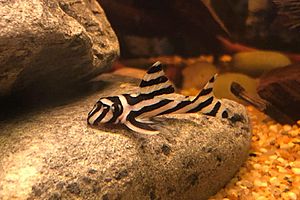Zebra pleco facts for kids
Quick facts for kids Zebra pleco |
|
|---|---|
 |
|
| A young zebra pleco | |
| Conservation status | |
| Scientific classification |
The zebra pleco (Hypancistrus zebra) is a special type of catfish. It lives only in a small part of the Rio Xingu in Brazil. This fish is found in the big bend area of the river, near the town of Altamira, Para. Scientists first described it in 1991. It gets its name from its black and white stripes, which look a lot like a zebra's stripes. This fish can grow to be about 6.4 centimeters (2.5 inches) long.
Zebra plecos were once caught in Brazil and sold as aquarium fish. However, the Brazilian government now protects them. It is against the law to export many fish species, including the zebra pleco.
The Hypancistrus zebra is in danger because of the Belo Monte Dam on the Xingu River. This dam has greatly reduced the water flow where these fish live. Because of this, the zebra pleco is now listed as critically endangered. This means it might soon disappear from the wild. Luckily, there are programs to breed them in captivity. Many are also bred by people for the aquarium trade.
Male zebra plecos have wider heads than females. They also have longer spines near their gills. After the female lays eggs, the male will guard them. The baby fish, called fry, start swimming after about seven days. They use up their yolk sac, which is like their first food supply, in about two weeks.
Contents
Caring for Zebra Plecos in an Aquarium
If you want to keep zebra plecos, your fish tank should be at least 115 liters (30 gallons). It is very important to keep the water just right for them.
The best water temperature for their tank is between 26°C and 31°C (79°F and 88°F). The water should be slightly acidic, with a pH level from 6.5 to 7.0. The water hardness should be between 2 and 6 dKH.
Hypancistrus zebra fish are sometimes called by special numbers. These are called L-numbers. For this fish, two numbers are used: L-046 and L-098. Zebra plecos are predators, meaning they hunt for food. They need a diet high in protein. This usually includes small bugs like insect larvae. In an aquarium, they often eat fresh or frozen bloodworms and brine shrimp. They also like algae wafers. Sometimes, they can eat vegetables like lettuce, cucumber, and squash.
These catfish should not be kept in a typical community aquarium. They also should not be with fish like discus. Zebra plecos do best in tanks that look like their natural home. They like small, peaceful fish that do not compete for food.
The tank should have a bottom made of small, smooth gravel and pebbles. It should also have smooth rocks and boulders. These form caves and hiding spots. The water must have lots of oxygen and a strong current. The surface of the water should be moving.
Zebra plecos are expensive fish. This is because only a few can be caught or bred. They are not hard to keep, but they need clean, warm water. They also need a fast-moving current. They will not do well in still or dirty water. These fish are active at night. They are a bit territorial and like many places to hide.
In 2004, the zebra pleco was added to a list of endangered species in Brazil. This made it illegal to export them from Brazil. However, some people still try to smuggle them out of the country. They then sell them in other countries, mainly Colombia.
Reproduction and Life Cycle
Like other Hypancistrus species, the male zebra pleco will guide the female into a cave. There, she will lay her eggs, and the male will fertilize them. This usually happens when the water pH is around 6.5-7.2 and the temperature is about 27°C (80.6°F). This process can take from one to five days. It depends on how experienced the female is at laying eggs. The male might gently bite the female to keep her in the cave. This is normal behavior for them.
Once the eggs are fertilized, the female leaves the cave. The male will then guard the eggs until they hatch. He might even stay to watch the babies grow into fry. When the fry are born, they have a yolk sac on their belly. This sac provides them with food and usually disappears in a few days.
Protecting the Zebra Pleco
The zebra pleco is listed in Appendix II of the Convention on International Trade in Endangered Species (CITES). This means that trading these fish internationally is controlled. Even fish bred in captivity need special permits to be traded between countries. This helps protect the species.
See also
 In Spanish: Hypancistrus zebra para niños
In Spanish: Hypancistrus zebra para niños
- List of freshwater aquarium fish species


